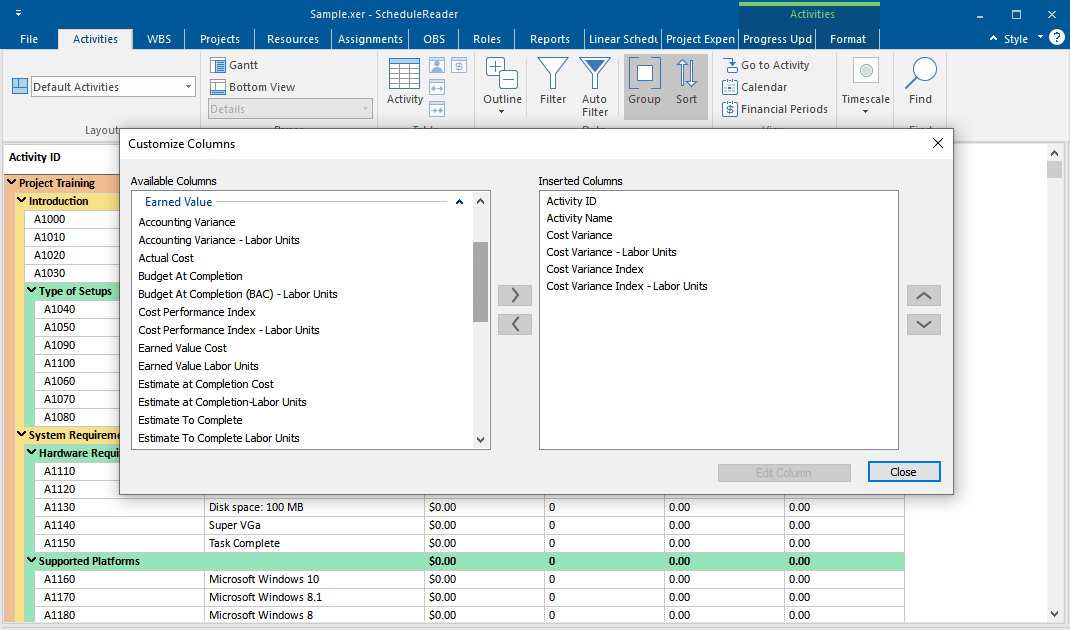The article below covers the basics principals of Earned Value Management, EVM calculations the basic EVM formulas, and its implementations in Primavera P6. Hope this article will help you get a better understanding of the EVM measurement system.
What is Earned Value Management?
As a measurement technique, Earned Value Management (EVM) is of great importance to help project managers and controls in measuring project performance and progress. This systematic process is used to measure project performance against cost and schedule, and to find variances in projects based on the comparison of worked planned and worked performed. In fact, calculating Earned Value will present the big picture of the actual project to project schedulers, project controls, as well as project managers. It allows them to monitor the project scope, actual and budgeted costs, and project performance. Earned Value Management will help project schedulers and controls to make the needed adjustments to the project strategy and perform an in-depth analysis of the project budget.
Moreover, EVM can be used in project forecasting. As a scheduler, calculating Earned Value allows you to track the project plan, actual work, and work completed value. But, as a project manager, EVM provides the ability to compare how much work has been completed against how much work you expected to be completed at a given point in time. Therefore, Earned Value Management gives schedulers and managers a clear objective way of measuring work performance and predicting future outcomes.
Earned Value Management Formulas – EVM Formulas
Monitoring your project’s overall performance includes whether the project’s activities are on, ahead, or behind schedule and on, under, or over budget. Comparing the actual expenditures cannot tell you where your project stands. This is where Earned Value Management kicks in.

As a project control, scheduler, or project manager, you need to understand there are numerous different earned value and EVM formulas applied in various situations that can help you figure out if the value of your project is equal to the costs you are spending. Below is a list of the most used EVM formulas and EVM calculations in the Earned Value Management System.
Planned Value (PV)
Planned Value is the approved budget for work scheduled to be completed by a certain date in the future. In comparison with Earned Value, PV is a proactive calculation that shows you how much you should have spent to a certain date in the future. Planned Value is also known as Budgeted Cost of Work Scheduled (BCWS).
If you want to find the Planned Value at some point, you need to add up all planned costs up to that point in the project. Your planned costs are referenced from the project’s baseline.
Actual Cost (AC)
The Actual Cost is a realized cost for the work performed on a specific activity during a certain period of time. It shows the money spent on an activity during a given period of time. Actual Cost is also called ‘Actual Cost of Work Performed’ (ACWP).
Actual Cost is an increasing value that gradually grows as the project progresses.
Budget at Completion (BAC)
Budget at Completion is the sum of the total budgets that are expected to be spent on the performed work. It shows how much money was initially planned for the project to cost. BAC is simply the total project budget that is summed up of all tasks’ budgets.
| BAC = Total Project Budget |
Earned Value (EV)
Earned Value is the amount of the work that is actually completed presented as the value of the performance budget assigned to that work. Earned Value in construction is also known as the Budgeted Cost of Work Performed (BCWP), and it is calculated as the Budget At Completion (BAC) multiplied by the Percent of Work Completed.
EV = BAC x % Complete
For instance, if the actual percent complete is 30% and the budget is $10,000 then EV is $3,000.
EV= $10,000 x 30%
EV= $ 3,000
Schedule Variance (SV)
Schedule Variance shows the difference between where we planned to be and where we are actually in the schedule. In fact, it tracks whether we are behind, ahead or on schedule with the project. Schedule Variance is calculated as a difference between Earned Value and Planned Value.
SV = EV – PV
The task is behind schedule if SV is negative. It was less work done than was planned.
For instance,
EV = $3,000 PV= $3,500 SV= $3,000 – $3,500 SV= – $500
The task is ahead of schedule if SV is a positive value. It was more work done than was planned.
For instance,
EV = $3,000 PV=$2,000 SV = $3,000-$2,000 SV=$1,000
The task is on schedule if SV is zero.
For instance,
EV = $3,000 PV=$3,000 SV=$3,000 – $3,000 SV=0
Schedule Performance Index (SPI)
Schedule Performance Index shows the rate at which the project performance is meeting schedule expectations up to a certain point in time. It gives the project manager to see the overall schedule efficiency of the project. SPI is calculated if you divide Earned Value by the Planned Value.
SPI=EV/PV
The task is behind schedule if SPI is smaller than 1. SPI <1
For example,
EV=$3,000 PV=$3,500 SPI=$3,000/$3,500 SPI =0.85
In this example, SPI is 0.85, and the task is 28% behind schedule.
The task is ahead of schedule if SPI is bigger than 1. SPI >1
For example,
EV=$3,000 PV=$2,500 SPI=$,3000/$2,500 SPI=1.2
In our example, the SPI is 1.2 which means that the task is 40% ahead of schedule.
The task is on schedule if SPI equals 1. SPI=1
For instance,
EV= $3,000 PV=$3,000 SPI=$3,000/$3,000 SPI=1
Cost Variance (CV)
Cost Variance is the difference between what was planned to spend, and what was actually spend. It shows the amount of the value that you earned on an activity and the actual cost that was required to performed that task. The Cost Variance shows the project manager how far the task is over, under, or on budget.
CV = EV – AC
The task is over budget if CV is negative.
For instance,
EV = $3,000 AC= $3,500 CV = $3,000 – $3,500 CV= – $500
The task is under budget if CV is positive.
For instance,
EV = $3,000 AC = $2,500 CV=$3,000-$$2,500 CV= $500
The task is on budget if CV is zero.
For instance,
EV=$3,000 AC=$3,000 CV=$3,000-$3,000 CV=0
Cost Performance Index (CPI)
Cost Performance Index is the rate at which project performance is meeting planned costs during a specific period of time. It shows project managers not only how much money is spending to deliver a project, but also how well that money is spent. CPI is calculated as a ratio of the Earned Value to the Actual Cost.
CPI= EV/AC
The task is over budget if CPI is under 1. CPI <1
For example,
EV = $3,000 AC = $3,500 CPI = $3,000/$3,500 CPI= 0.85
In this example, CPI is 0.85 which means that the task is 28% over budget.
The task is under budget of CPI is over 1. CPI > 1
For example,
EV=$3,000 AC =$2,500 CPI=$3,000/$2,500 CPI =1.2
In our example, CPI is 1.2 which means that the task is 40% under budget.
The task is on budget if CPI equals 1. CPI = 1
EV = $3,000 AC=$3,000 CPI=$3,000/$3,000 CPI= 1
Estimate at Completion (EAC)
Estimated at Competition shows the expected total cost when completing all tasks. It presents the total cost at completion based on project performance up to a certain point in time. The basic formula for calculating EAC is if you divide the approved budget with the cost performance index.
EAC=BAC/CPI
If the future work is completed at a planned rate then the EAC can be calculated following this formula:
EAC=AC+BAC-EV
If the first plan is no longer accurate, then you can calculate EAC using this formula:
EAC=AC=ETC
If the project’s future is influenced by the Cost Performance Index and Schedule Performance Index, you can use this formula for calculating EAC:
| EAC= AC+ [(BAC-EV) (SPIxCPI)] |
Estimate to Complete (ETC)
Estimate to Complete shows project managers how much money will take to finish the remaining tasks of the project. Based on past performance, this value projects how much more money will be needed to complete the project. To calculate ETC you need to subtract the Estimated at Completion with the Actual Cost.
ETC=EAC-AC
Keep in mind that you will need to perform other calculations if the past project performance changes.
Variance at Completion (VAC)
Variance at Completion projects the amount of budget needed (or leftover) to complete the project. This value can be calculated as a difference between Budget at Completion and the Estimate at Completion.
VAC=BAC-EAC
You will need more money to complete the project if VAC is negative.
For instance,
BAC= $20,000 EAC=$25,000 VAC= $20,000-$25,000 VAC=-$5,000
In this example, you will need an extra $5,000 to finish the project.
If VAC is positive, the rest of the amount is the surplus.
For example,
BAC=$20,000 EAC= $18,500 VAC= $20,000-$18,500 VAC= $1,500
You will finish the project with an extra $1,500.
To Complete Performance Index (TCPI)
To Complete Performance Index shows the project manager the performance that must be achieved to meet the budget or schedule. It projects an indication of how much efficiency needs to be gained to make up for past negative variances.
If the project is obligatory to finish within the original budget, you can follow this formula to calculate TCPI.
TCPI= (BAC-EV)/(BAC-AC)
If the project budget is flexible, use this formula to calculate TCPI:
TCPI=(BAC-EV)/(EAC-AC)
Depending on your role in the team, these EVM formulas come in handy when you want to see where your project stands.
The Importance of EVM in Primavera P6
Earned Value Management has become a valuable part of all major project portfolios. Even though there are numerous project management software solutions, but not everyone has the ability to deliver the variances you need. Without an integrated earned value process, the troubled projects can easily get out of control before anyone sees a problem. Primavera P6 has completely integrated Earned Value Management functionality which allows its users to join cost and schedule information into a single solution and generate the statistically accurate estimates that are needed to communicate project performance.
Earned Value Management in P6 delivers complete answers that provide detailed cost information with project schedules by aligning and combining project performance data from Costs, adding complex burdening rates, and tracking committed costs. One of the most important benefits of EVM in P6 is that Earned Value updates become dynamic in parallel with the schedule logic. When the project schedule is synchronized with Earned Value Management within the scheduling software, it will provide a dynamic view that will enable project teams to establish valuable predictions and forecasts that may save the project.
Finally, EVM will reveal poor scheduling or an inability to deliver a good plan. This process provides important insights into a project’s current cost and schedule status that will help project managers maintain a balance between the costs, schedule, and scope.
Earned Value Management in ScheduleReader
Primavera P6 is a costly tool that only a few people in the project team really need it. The others that are not schedulers can review the schedule with the help of a standalone software solution that opens project data from Primavera P6. That tool is ScheduleReader.
In its latest 7.5 version, ScheduleReader introduced Earned Value Analysis as one of the fully integrated functionalities. With cutting costs on P6 licensing, you will get a complete XER reader with a reasonable price that has completely synchronized Earned Value Management.

ScheduleReader works on the project’s Baselines as a foundation for calculating Earned Value functions, which are placed on the P6 default settings and available in the Activity View. You can easily create layouts with specific EVM formulas and EV cost, work, and time parameters. Or you can import layouts that are exported from P6.
ScheduleReader completely delivers the three most important benefits of Earned Value Management:
- The right point on where you are in the project to date
- Forecast future performance, costs, and completion dates
- Maintain control and project delivery on time and on budget
Moreover, ScheduleReader PRO allows its users to analyze different EV parameters that can be presented and summarized with graphical reports for a better view.
Conclusion
The knowledge to perform Earned Value Analysis and EVM formulas is considered to be a valuable set of skills for project schedulers, controls, or project managers. Building a strong Earned Value Management System will give you the benefits of successfully delivering any projects.
Hope we covered the basics of EVM formulas and EVM calculations. And if we didn’t cover something important, feel free to write to us at [email protected].

